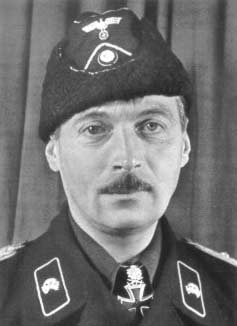Count Hyazinth Strachwitz |

|
In 1934, Strachwitz attended army manoeuvres near Breslau and became interested in new armoured fighting vehicles and motorized formations. In 1935, he joined a large cadre being transferred to the newly formed 2nd Panzer Regiment, which was stationed at Eisenach and became the core of 1st Panzer Division. The Count fought with his unit in Poland (1939), France (1940) and Balkans (1941) often showing his boldness and tactical creativity on the battlefield. In the early stage of the German invasion of the Soviet Union in 1941, Strachwitz commanded the 18th Panzer Battalion in 18th Panzer Division, where he became a popular and respected field commander with great tactical skills. He soon gained the nickname of Der Panzergraf - The Panzer Count. He took part in major battles of the early fighting on the Eastern Front, including crossing of Bug and fighting at Brody-Dubno. At this stage, The Panzer Count became known for his daring tactics, which often result in heavy losses inflicted upon the Red Army by his unit. In 1942, Strachwitz was promoted to the rank of Lieutenant Colonel and advanced with 16th Panzer Division in von Paulus' 6th Army to Stalingrad, where was wounded and evacuated escaping the fate that fell upon the 6th Army. In the same year, he was awarded the Oak Leaves to his Knight's Cross. Upon his return, Strachwitz received the command of panzer regiment of elite Grossdeutschland division. The 3rd Battalion of the panzer regiment was equipped with heavy Tiger I tanks. On March 28th of 1943, Colonel Strachwitz was awarded the Swords to the Oak Leaves of the Knights' Cross during heavy fighting around Kharkov. Strachwitz then took part in the fighting during the Operation Citadel in the Summer of 1943. Following the failure of the operation, German units were forced to retreat. During this time, Strachwitz showed to be only skilful in attack but also in defence. He quickly understood patterns followed by Soviet commanders during attacks and launched numerous local counterattacks into their flanks and rear. Strachwitz became an expert in creating tank-killing grounds destroying countless Soviet tanks in short periods of time. On April 1st of 1944, Strachwitz was promoted to the rank of Major General and commanded 1st Panzer Division for a short period. On April 15th of 1944, Strachwitz was awarded the Diamonds to the Oak Leaf of the Knight's Cross (11th recipient of the award) for his actions at Tuccum and Riga. In late 1944, became senior panzer officer of Army Group North responsible for reorganizing panzer and panzergrenadier units. At the same time, he commanded Panzerverband Graf Strachwitz (also known as Kampfgruppe Strachwitz) in the summer of 1944 operating in Lithuania. Strachwitz was also a holder of the German Cross in Gold, which was awarded for bravery. Strachwitz was involved in a serious car accident. He barely survived and returned to service, ordered to raise tank destroyer brigade at Bad Kudova.
As the war situation became more and more desperate, Strachwitz fought his way through Czechoslovakia to reach Bavaria, where he dissolved his command and ordered all men to surrendered to the Western Allies. He became a prisoner of war, this time of US Army. During the war, he lost his two sons, while his wife died in an accident shortly after the war, while he was a POW. Strachwitz lost his property in Silesia, which was confiscated by the Soviets and started his new life in West Germany, where he married again. In early post-war period, Strachwitz was invited to Syria to help reorganize their agriculture and army but he was soon on the run as the government, which invited him was overthrown. He reached West Germany in 1951 and lived at an estate in Chiemsee in Bavaria. Der Panzergraf died in 1968 and officers of the Bundeswehr held a watch at his coffin as a sign of recognition for his outstanding military career. He is buried at Grabenstätt, Germany.

Copyright@1996-2006
